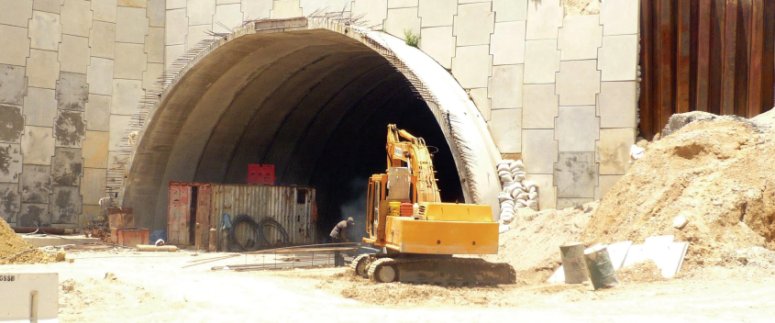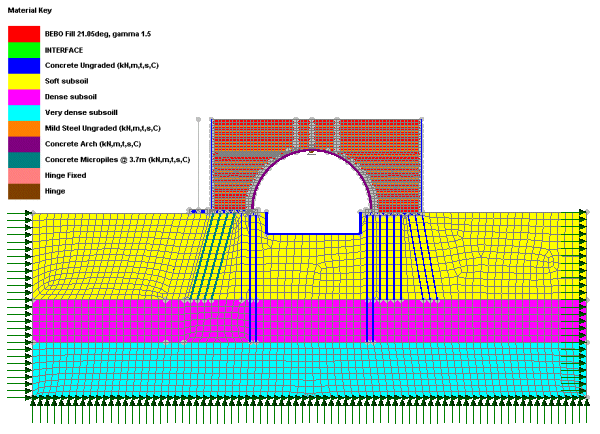Additional Information
Geotechnical and Soil-structure interaction
analysis
Unlike some structural analysis
software selected LUSAS Civil & Structural plus and LUSAS Bridge
plus software products, when used with appropriate geotechnical, nonlinear, dynamic
and thermal/field software options, provide a range of
soils-specific and general structural engineering analysis tools
to enable finite element modelling in 2D or 3D of both ground and structure in
a single model.
Multiple analyses can be solved within each model,
and state-of-the-art linear and quadratic element libraries;
advanced material models; and linear and nonlinear joint models
allow a range of soil-structure engineering problems to be solved.
|

Modelling
- LUSAS models are created using
feature-based geometry methods (points, lines, surfaces and volumes)
and built-in associativity, a key feature of the LUSAS Modeller,
ensures that if the model geometry is amended, all assigned
loadings, supports, mesh and other attributes are automatically
updated to suit.
CAD import / export facilities
permit importing of point and line data from DXF files; points, lines,
surfaces and volumes via IGES/STEP interafaces; and triangulated
surface data through STL. CAD-style drawing tools provide an array of
modelling utilities such as copy, rotate, scale, transform, extrude
etc.
For 2D modelling splines can be
created from terrain points data and swept to create strata. Surfaces
can be defined from bounding points and lines, and swept to define a
soil mass. Structural and soil components can be grouped for modelling
purposes. For 3D modelling, planar or curved surfaces can be swept for
multiple volume creation, and intersection and subtraction commands
provide the means to slice volumes or create voids.
Automatic 2D meshing (using
quadrilateral/triangular elements) and 3D meshing (using
tetrahedral/pentahedral/hexahedral elements) speeds up the modelling
process. Various mesh refinement methods are provided.
- Calculate
initial stress states providing K0
data and apply to any ground profile.
- Constitutive
soils models include Tresca, Von Mises, Drucker Prager, Duncan-Chang, Mohr Coulomb,
and Modified Cam Clay.
- Two-phase material properties can be added to
selected materials to permit modelling the deformation of
undrained/fully saturated and fully-drained/unsaturated porous media,
and slow consolidation process. Draining and filling curves can also
be specified for partially drained materials.
- Model the variation of
soil properties with depth by defining soil profile variations, with
LUSAS interpolating between defined locations.
- Nonlinear
springs model active/passive soil joints. Interface meshes permit
joining of the soil / structure. Gain / loss of contact, and skin
friction can be considered.
- Specify a matrix of
properties to represent a pilecap sitting on a group of piles in a
3D model.
A Tri-linear
(active/passive) earth pressure joint material wizard simplifies the modelling of a
variety of soil-structure interaction problems, creating a piecewise
linear joint material attribute with properties that vary with depth.
Multiple attributes can be defined to represent layers of soil or
changes in properties due to the presence of water.

Typical applications
LUSAS is used in all areas of civil,
structural and bridge engineering for linear, nonlinear, seismic, blast,
buckling, impact and thermal/field analysis. It can be used on all types
of structures from simple slabs, buildings, towers, tanks and
bridges through to heavy civil engineering structures such as
dams, docks and tunnels.
General geotechnical and soil-structure interaction
capabilities include:
- Construction sequence modelling -
involving excavation / construction with insertion and removal of
temporary members used for propping and jacking etc.
- Embankment /slope stability
assessments and stability checks on adjacent structures due to
temporary excavation.
- Backfilling of excavations and cut and
cover tunnel structures.
- Settlement and consolidation including
pore water pressure modelling.
- Dewatering and seepage modelling of
partially saturated fluid flow through porous media, such as seepage
of water through an earth dam, where the position of the phreatic
surface is of interest.
- Modal and time history dynamics
involving material damping, nonlinear behaviour, soil plasticity,
boundary behaviour and springs/dampers.
- Soil-structure interaction analysis
including vibration analysis from pile driving impact assessments on
nearby buildings and response of buildings to emitted vibrations
from rail tunnels.
- Lateral displacement analysis of piles
and pile groups
- Integral bridges

|
|
Software Information
|